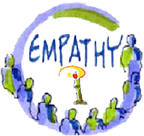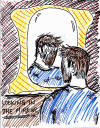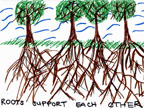|
|
About: Human Centered
Design - Design Thinking
http://j.mp/14Xsuwq
"Empathy is the centerpiece of a human-centered design process. The
Empathize mode is the work you do to understand people, within the
context of your design challenge. It is your effort to understand the
way they do things and why, their physical and emotional needs, how they
think about world, and what is meaningful to them.
WHY empathize? As a design thinker, the problems you are trying
to solve are rarely your own—they are those of a particular group of
people; in order to design for them, you must gain empathy for who they
are and what is important to them"
Introduction
to Design Thinking - by D.School
Human Centered Design > Entrepreneurship
> Leadership >
PEOPLE
|
|
|
David
Kelley
|
 |
|
"As
founder of IDEO, David Kelley built the company that created many
icons of the digital generation—the first mouse for Apple, the first Treo,
the thumbs up/thumbs down button on your Tivo’s remote control, to name a
few. But what matters even more to him is unlocking the creative potential
of people and organizations so they can innovate routinely.David’s most
enduring contributions to the field of design are a human-centered
methodology and culture of innovation. More recently, he led the creation
of the groundbreaking d.school at Stanford, the Hasso Plattner Institute
of Design." |
|
How to
design breakthrough inventions -Use Empathy - 60 Minutes
"Global firm IDEO
incorporates human behavior into product design -- an innovative
approach being taught at Stanford. Charlie Rose profiles the company's
founder, David Kelley."
Design Thinking for Social Good: An Interview with David Kelley
Avi: So Needfinding is a way of locking onto the critical problems
because there are so many problems to solve.
David: You're absolutely right. The way to do it is to go out and
figure out what humans actually value. Having 'empathy' for people was
so exciting. You don't usually think of engineers as people people, so
to speak, but my experience has been that when engineers really feel
that something would be important to people, would have meaning in
people's lives, that's highly motivating and it makes them work really
hard.......
Avi: What are the characteristics of a designer?
David: The characteristics of a designer that I appreciate the
most are this thing about having 'empathy' for people, that you expect
to get your big ideas from talking to people and your own experiences,
that you have a bias towards action, that you're not going to sit around
and noodle strategy details for a long time, you're going to actually go
out and build something and show it to people and iterate the
feedback....
At some point by observing these people and building empathy for
them you start to have insights about them. "Oh, they really do value
this. It's not obvious at first that that's what they really value.
By Avi Solomon"
|
|
|
Seung Chan Lim (Slim)
|
 |
|
Seung Chan Lim, better known as
Slim, is the director for project Realizing Empathy. Realizing Empathy is
a project that asks what it means to make something, how it works as a
process, and why it matters to our lives. It explores these questions
across disciplines such as fine arts, performing arts, design, science,
and engineering. |
"As a designer, I must find ways to harness the most complex
of technologies into an experience that is not only pleasant, but also
empowering and meaningful. As an engineer, I must make sure that I can not
only talk the above talk, but also walk the above walk. As a strategist, I
must make sure that the talk is not only talked, but heard, and the walk is
not only walked, but seen."
"What I have learned from this experience is that making things is
analogous to engaging in an empathic conversation with another person."
Q&A: Seung Chan Lim on improving human centered design |
SmartPlanet
What does empathy have to do with innovation and technology?
According to Rhode Island based designer Seung Chan Lim,
plenty and not enough.
SP: The corporate environment seems like the perfect place for
more empathy.
SCL: Yes! I think so, too. When you get down to it, you
realize that corporations are filled with really smart and
capable people but the organizational structure doesn’t allow
them to utilize their talents in ways that is conducive to
doing great work.
I’m also trying to raise funds for the next phase, which is to
prototype a new kind of human-computer interaction paradigm
for making software. I’m underwhelmed by the two predominant
paradigms, textual programming and visual programming. I’d
like to imbue the principles of empathic conversation into
this domain."
“The Role of Empathy in Design Thinking”
This year we will host an evening event at SAP TechEd
LasVegas called:
When: Wednesday, October 17th, 7:30 p.m. SAP TechEd Las
Vegas
Who: Available at no extra charge to SAP TechEd
registrants only
How: First-come, first-served basis: advance sign-up is
required for reserved seating. Since Design
Thinking starts with the ability to empathize, we will not
only showcase what empathy means as part of the design
thinking approach, we will also expose participants to the
“how” of practicing empathy in the design process.
Youtube
Videos
Playlist:
The Role of Empathy in Design Thinking
Post-Workshop Panel on "Making as Empathic Conversation"
Realizing Empathy: An Inquiry Into the Meaning of Making
(Teaser)
Creativity, Innovation, and Transformation as Side Effects
of Empathizing
Sub Conference: Human Centered Design
|
|
|
|
Dave McColgin & Edwin Rutsch:
How to Build a Culture of Empathy with Product Design
|
 |
|
Dave McColgin works at Artefact Group, which is a
technology product design company. He wrote an article and white paper on,
"Why you should invest in empathy."
A major step in the product design process is to
empathize with the users needs in relation to designing any product. In
this interview Dave walked me, step by step, through his article. |
The
'Empathy:
Design tool and outcome' whitepaper. "describes additional
background on the concept of empathy and answers design-related questions
like:
-
How can decision makers get a better intuitive sense of their customers
to complement the faceless data?
-
What are some creative ways that working teams can get a deeper sense of
walking in their customers' shoes?
-
How can you recognize when there is an opportunity to increase empathy
among customers?
-
How does technology act against empathy today and what can we do about
it?"
Artefact:
Why you should invest in empathy
by Dave
McColgin
"Artefact’s pursuit of 21st Century Design aspires toward
preferable outcomes to benefit society, the economy, and the
environment. We believe that lives are larger than
interactions with a product, that users are more than targets
and sources of growth. Instead they are partners in achieving
societal goals. As designers, we can carefully choose what
outcomes will lead to progress. In order to do that
successfully, we need to approach our work with empathy –
empathy towards the user, the context of the situation, and
society. In this post and accompanying paper, we will explore
the concept of empathy: why it matters in design and how we
work to achieve this outcome in our work."
Artefact: From Theory to Practice: Designing for Empathy
"At Artefact, increasing the sense of empathy between people
is an outcome we always strive towards as designers. It is a
key part of our pursuit of 21st Century design because we
believe that more empathy in the world is good-ness. It leads
to a greater sense of understanding between people, better
collaboration and more meaningful products overall. (For a
more detailed discussion of empathy, see our paper). But, as
with any big idea, the questions remain: How do we design for
empathy in practice? Is there a process that can help us stay
focused on empathy as one of our design goals? For the past
ten months, we’ve been investigating this at Artefact."
Sub Conference: Human Centered Design
|
Museum:
Design Thinking for Museums: From Empathy to Innovation
"Slides from a half-day workshop I co-led at the 2013 Museum Computer
Network conference in Seattle. (innovation)
Design Thinking is a human-centered, prototype-driven process for
innovation. In this half-day workshop, participants experienced
firsthand the complete Design Thinking cycle through a hands-on, highly
interactive session."
Museum:
Empathy as the starting point for innovation
"One of the core principles of design
thinking is
its focus on human values at every stage of the process. And empathy for
the people for whom you’re designing is fundamental to this process....
I was struck by how their notion of empathy as starting point for
positive solutions is similar to design thinking. Design thinking is a
human-centered methodology for fostering creativity and tackling complex
problems through innovative solutions, and empathy is the lynchpin of
this process. "
Designing with Empathy - BD Conf,
April 2013 - Aaron Gustafson
"Every decision we make affects the way real people experience our
products. We’ve all heard the rallying cry for user-centered design, but
even those of us who ascribe to that ideal often fall back on our own
biases and instincts when it comes to making decisions about how people
experience our content and our service.
Sadly, this often means we make decisions we think will be good for our
"users"—that anonymous, faceless crowd—rather than actually trying to
understand the perspectives, surroundings, capabilities, and
disadvantages of the actual people who we are here to serve. "
Why Empathy Is At The Heart Of The DBC Experience (Dev
Bootcamp)
by Karim Bishay & Jesse Farmer
"Engineering Empathy is a philosophy and an approach that we have
developed to make sure that we’re training our students to become better
at learning, working in teams, and dealing with whatever their job or
life throws at them. We've crafted and are always improving on our
Engineering Empathy curriculum. "
50 Design Problems In 50 Days: Real Empathy For Innovation (Part 1)
"Empathetic understanding is a vital tool in fostering innovation. If we
can better understand the people we are designing for, the better our
decisions, designs and results will be. Travelling 2517 miles taught me
that if we wish to innovate, we must go beyond analyzing people’s
experiences and try and make them our own.
Understanding people better often requires us to get outside and get our
hands dirty but, in doing so, allows us to better analyze and solve....
To gain empathic understanding, rather than distanced analysis, go to
meet people where they are — in their environments, not in our labs.
Focus groups give us some insight into people’s experiences, but they
can’t enable true understanding."
MindSnacks CEO on
the importance of empathy
"Jesse Pickard believes the ability to empathize with other is important
for building customers and the right team."
8 Ways To Become A More Empathic Designer by Matthew Magain
"Empathy is one of the most important skills a UX Designer can possess.
But if it's so important to be empathic, how should we go about
improving? In a previous post I wrote that empathy was a core skill for
becoming an effective user experience designer. Several people commented
that the concept of empathy as being something you could learn (and
therefore be taught) was new to them—surely this is a character trait
that you either have, or you don’t?.
1. Notice Everyday Pain..
2. Be Present..
3. Shadow Your Users..
4. Walk A Mile In Their Shoes..
5. Find Common Ground..
8. Make Faces..
6. Role Play...
7. Review Research In A Group...
8. Find A Mentor..."
The Vision Before the Design: Empathy is the Key
"Reaching this vision takes a little time, planning and
empathy is at the center of the task. The most successful organizations
engage a broad spectrum of constituents.
Reaching this vision takes a little time, planning and empathy is at the
center of the task. The most successful organizations engage a broad
spectrum of constituents. It’s important to think about all of the
potential “users” of a healthcare facility. Not only are the
administrators and clinical staff important, but also patients, family
members and support staff. The next step is to bring these groups
together. Firsthand knowledge sharing is powerful."
It’s Time for Design to Start Empathy Too
"In this post, Matthew Manos takes a look at advertising
campaigns leveraged in the social sector and critiques their tendency to
deliver content that engages with sympathy instead of empathy. Empathy
is a really big word in design, specifically in the practice of “Design
Thinking.” However, this article examines a different role for empathy
in design, one that is very frequently overlooked.
In Design Thinking, empathy is what kicks off a project – it is
the first step in understanding what the end user might need by being
able to get hands-on experience understanding their problems and “pain
points.” The space in which empathy is quite absent from design,
however, is in communication materials, a medium that is historically
sympathetic. Sympathy, as opposed to empathy, does not foster a deep
understanding or emotional connection. Empathy, as opposed to sympathy,
is a way for us to develop our understanding by sharing an experience."
Project Visioning
Video
Empathy at scale | Design
Thinking
"One of the principles of design thinking is that it requires empathy
for users to inspire ideas. Normally we think about getting that from
ethnographic style research. Diving deep into the lives of a relatively
small number of people, understanding the environment they live in,
their social networks, seeing things first hand. We have lots of
evidence that this works but I sometimes wonder if we aren’t also
missing something. The problem with looking deeply at a few people is
that you miss the opportunity for insights that might come connecting
more broadly across cultures."
How empathy is leading the way in creative fields
"The new RSA animate video, The Power of Outrospection is quite
thought provoking and has gotten me thinking about all kinds of links
between empathy and creativity. In the video, philosopher Roman Krznaric
explores the idea that we live in a time that demands more empathic
adventurers in all aspects of life. Empathy not just so we act better
towards others, but also because it helps us create better innovations,
services and quality of life. By Ben Weinlick of Think Jar Collective"
Design
Empathy
"Here is a great presentation from Braden Kowitz on optimizing the
design process. Lot of insights around empathy and the importance of
testing often and early. Arthur has been putting a very simila..."
Design Thinking.
Bringing Empathy and Collaboration to Your Designs
"Design Thinking is a process of bringing integrative thinking,
experimentalism, collaboration and empathy into the design process in a
structured way. In this episode Vince and Allison walk us through the
empathy and collaboration aspects of this framework."
Design Thinking – Empathy
"When it comes to integrating Design Thinking into Product Concept
Design, Empathy is the crux of the matter. The goal of Design Thinking
is framing Product Concept Development in terms of a ‘human-centered’
approach, and Empathy is how you relate the needs of people to your
designs.
How to Build Empathy into your Next Product
While building Empathy into a product might seem like a
complicated task it really only requires two key components, both of
which are natural extensions of the way we do most things in life. They
are:"
Oracle OpenWorld's Customer Experience Summit Day Two: Understand the
Customer
"Oracle's first annual Customer Experience Summit featured plenty of
advice like when to hire a chief customer officer and how to create
empathy with customers.
It's Hard to Talk People into the Idea of CXM as being Important
This is where the idea of empathy comes into play. It's easier
for people to understand their customers if they can see things from the
customer's point of view. It turns out many businesses see customer
interactions simply as pain points, and that simply is not always how
customers see things."
|
|








